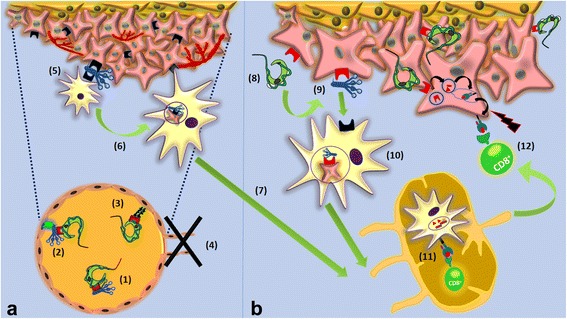Fig. 7.

Proposed extracellular mechanisms explaining, at least partially, the in vivo antitumor effect of T. cruzi infection. a TcCRT antiangiogenic effect: (1) T. cruzi exposes its CRT on the parasite surface, followed by C1 recruitment and inactivation; (2) On the ECs membrane, a trimolecular synapse is formed by cC1qR-C1-TcCRT, from EC, host and parasite origins, respectively; (3) SRs present on ECs bind TcCRT. The last two mechanisms, could activate antiangiogenic signals on ECs, with consequent inhibition of angiogenesis (4). Decreased nutrients and oxygen supply may constitute a stressful environment for the tumor, CRT will be exteriorized and C1 recruited (5). Dendritic antigen presenting cells (APCs), through their cC1qRs will recognize, internalize and process these tumor cells (6) on their way to local lymph nodes (7). b Possible nTcCRT-mediated induction of an anamnestic antitumor immune response: Parasite translocated TcCRT binds to the tumor cell (8), with subsequent capture of host C1 (9). This C1 will be recognized by cC1qR present on APCs, followed by internalization of this complex (10). Among many other possibilities, APCs will cross-process TcCRT and specific peptides from this parasite protein will be loaded onto MHC I molecules. APCs will enter the regional lymph node and present these nTcCRT-specific peptides to cytotoxic T lymphocytes, thus leading to their activation (11). These CD8+ cytotoxic T lymphocytes will leave the lymph node and kill tumor cells that also present TcCRT derived peptides (12)
